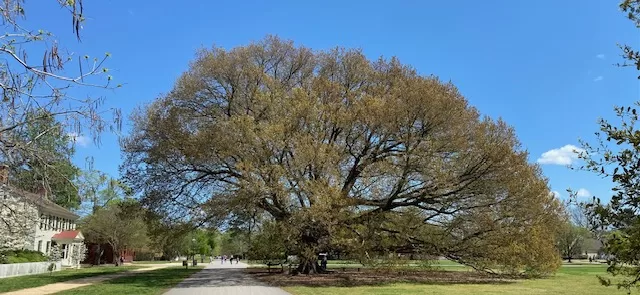"That the future may learn from the past."
As the world’s largest living history museum, Colonial Williamsburg has provided a unique partnership opportunity for the James City County/Williamsburg Extension Master Gardener Association and Peninsula Master Tree Stewards. This collaboration helps acquaint thousands of visitors with the learning opportunities available from the Master Gardener Association. Additionally, Master Gardener Tree Stewards provide communities with locally identified programs, including:
-
- Answers to individual arboretum-related questions through educational programs tailored to specific needs.
- Education for the preservation of historic landscapes within arboretums.
- Urban tree planting programs within arboretums.
- Guidance to make arboretums accessible to all residents, regardless of disabilities, income, or location.
What is an Arboretum?
An Arboretum is an area devoted to specimen plantings of trees and shrubs. Distinct from a forest, nursery, or park, it is, in a sense, an outdoor museum of trees. It is a place where many varieties of trees are grown for research, educational, and ornamental purposes and where trees and shrubs are cultivated for exhibition.
Why is the Arboretum important?
As a living history museum, the Colonial Williamsburg Arboretum is more than just a collection of plants. It is a dynamic institution that bridges the gap between past and present, offering a space where history is preserved, actively taught, and explored. It stands as a beacon of educational innovation and historical stewardship, inviting us all to partake in the legacy of Colonial Williamsburg and the natural world that shaped it.
Unique Trees
The Colonial Williamsburg Arboretum is a botanical treasure trove, showcasing a diverse array of tree species that hold historical significance. Among the arboretum's collection are 25-period species of oak trees, each telling a story of the past with their sturdy branches and deep roots. The Compton Oak, a natural hybrid between the live oak and overcup oak, stands as a state champion big tree, its grandeur symbolizing the blend of natural beauty and historical legacy. The American Beech, with its long arbors gracing the Governor’s Palace north garden, is a testament to the longevity and resilience of native species. The Paper Mulberry, introduced in the 1780s, offers a glimpse into the colonial era's horticultural practices, reflecting Thomas Jefferson's appreciation for its dense shade. The arboretum also boasts the jujube, a state champion tree, which adds an exotic touch to the collection with its origins in the Far East. These species, along with many others, form a living museum of flora that not only enhances the aesthetic appeal of the historic area but also serves as an educational resource, illustrating the intricate relationship between humans and nature through the centuries. Visitors to the arboretum can immerse themselves in this botanical narrative, gaining insights into these trees' ecological and cultural heritage. The arboretum's dedication to preserving and presenting these species ensures that each tree's story continues to be told, allowing future generations to learn from the rich tapestry of the past.
Dream to Reality
The James City County Williamsburg Master Gardener Tree Stewards have been instrumental in developing the Colonial Williamsburg Arboretum. Their dedication has enriched the area's botanical diversity and transformed it into a living classroom for visitors and locals. In 2018, a group of committed Master Tree Steward volunteers recognized the significance of the arboretum's collection of trees and woody plants, many native to the Mid-Atlantic region or introduced to the Virginia Colony before 1800. They undertook a meticulous project to assemble historical records and inventory the diverse species within the 300+ acre Historic Area. By July 22, 2019, the arboretum attained Level II (100 trees and/or woody shrubs tagged). The eventual, long-term goal is for the arboretum to become a fully accredited Level III (500 trees and/or woody shrubs tagged) national arboretum. Work is ongoing to achieve that goal. The only Level III arboretum in the Commonwealth is Arlington National Cemetery.
Cooperative Effort
The work of the Tree Steward volunteer has provided a high level of visibility for the educational programs of the Virginia Cooperative Extension Master Gardeners and supported the mission to serve communities throughout the Commonwealth. The Colonial Williamsburg Arboretum now stands as a testament to the stewardship of these individuals, offering a tangible connection to the past through its historic landscapes while promoting environmental education. The Master Gardener Tree Stewards' efforts have ensured that the arboretum is not only a repository of botanical heritage but also a dynamic educational resource that informs visitors about the region's natural history and the importance of preserving such landscapes for future generations. The impact of the Colonial Williamsburg Arboretum extends beyond its boundaries. It supports the mission of the Virginia Cooperative Extension Master Gardeners by promoting educational programs, preserving historic landscapes, and guiding urban tree-planting initiatives. The arboretum's work underscores the importance of community engagement and knowledge sharing to foster a deeper appreciation for our shared history and natural environment.
How to Learn More
For those interested in experiencing the arboretum firsthand, the Colonial Williamsburg website provides information on current events, activities and tours, ensuring that every visit is as informative as enjoyable. Whether you are a history buff, a gardening enthusiast, or simply someone who appreciates the beauty of nature, the Colonial Williamsburg Arboretum is a destination that promises to enrich and inspire. Come out and talk to a Master Gardener Tree Steward.
Related Posts:
- Colonial Williamsburg Arboretum Article
- The Compton Oak
- Bassett Trace Nature Trail
- Arthur A. Shurcliff's Gift to the Future
Colonial Williamsburg (CW) Arboretum Information:
- Arboretum Map (Interactive)
- Nine Old Trees Map (Interactive)
- National & State Champion Trees In CW Arboretum (Interactive)
- Bassette Trace Nature Trail Map
Other Resource For Tree-Huggers:











